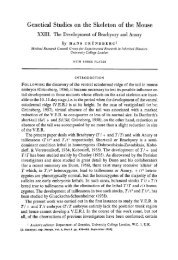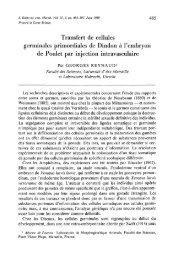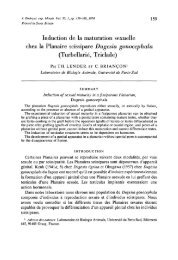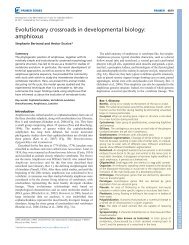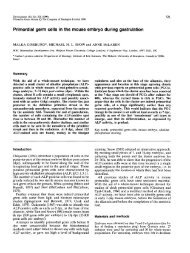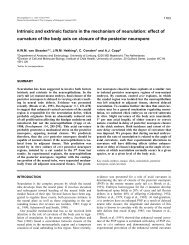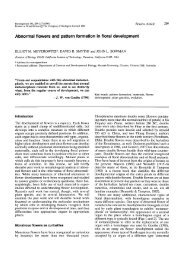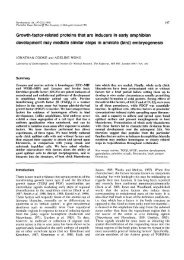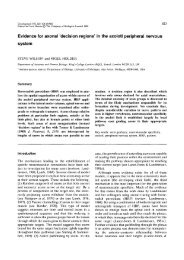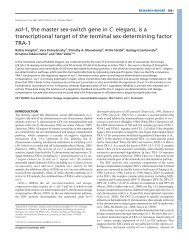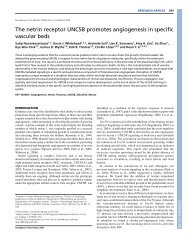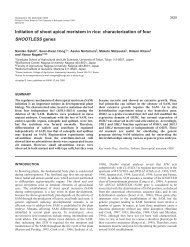Effects of insulin insufficiency on forelimb and tail ... - Development
Effects of insulin insufficiency on forelimb and tail ... - Development
Effects of insulin insufficiency on forelimb and tail ... - Development
Create successful ePaper yourself
Turn your PDF publications into a flip-book with our unique Google optimized e-Paper software.
430 SWANI VETHAMANY-GLOBUS AND R. A. LIVERSAGE<br />
was detected <strong>and</strong> recorded. The right <strong>forelimb</strong>s <strong>and</strong> <strong>tail</strong>s <str<strong>on</strong>g>of</str<strong>on</strong>g> the pancreatectomized<br />
animals were amputated at the <strong>on</strong>set <str<strong>on</strong>g>of</str<strong>on</strong>g> diabetes.<br />
Up<strong>on</strong> terminati<strong>on</strong> <str<strong>on</strong>g>of</str<strong>on</strong>g> the experiments limb <strong>and</strong> <strong>tail</strong> regenerates <strong>and</strong> the pancreatic<br />
tissues <str<strong>on</strong>g>of</str<strong>on</strong>g> the experimental <strong>and</strong> c<strong>on</strong>trol animals were fixed in Bouin's<br />
fluid. Limb <strong>and</strong> <strong>tail</strong> regenerates were decalcified in Jenkins' soluti<strong>on</strong>, secti<strong>on</strong>ed<br />
at 8 /an <strong>and</strong> stained with hematoxylin <strong>and</strong> counterstained with orange G-eosin.<br />
Pancreatic tissue was stained with aldehyde fuchsin, P<strong>on</strong>ceau de xylidine-acid<br />
fuchsin <strong>and</strong> counterstained with fast green (Epple, 1967).<br />
RESULTS<br />
<str<strong>on</strong>g>Effects</str<strong>on</strong>g> <str<strong>on</strong>g>of</str<strong>on</strong>g> pancreatectomy <strong>on</strong> <strong>forelimb</strong> <strong>and</strong> <strong>tail</strong> regenerati<strong>on</strong><br />
Pancreatectomized animals excreting 0-1 % glucose in the urine survived for<br />
periods <str<strong>on</strong>g>of</str<strong>on</strong>g> up to 52 days, but those excreting 0-25 % glucose died within 15 days<br />
after pancreatectomy. It was difficult to keep animals alive in a prol<strong>on</strong>ged state<br />
<str<strong>on</strong>g>of</str<strong>on</strong>g> diabetes; nevertheless, a minimum period <str<strong>on</strong>g>of</str<strong>on</strong>g> 25 days from the time <str<strong>on</strong>g>of</str<strong>on</strong>g> amputati<strong>on</strong><br />
is required to observe changes in limb regenerati<strong>on</strong>. Therefore, the majority<br />
<str<strong>on</strong>g>of</str<strong>on</strong>g> cases were fixed 25 days post-pancreactectomy. The results are summarized in<br />
Table 1. The regenerates will be c<strong>on</strong>sidered in two groups: Group A is composed<br />
<str<strong>on</strong>g>of</str<strong>on</strong>g> regenerates fixed 25-35 days post-pancreatectomy; whereas Group B c<strong>on</strong>sists<br />
<str<strong>on</strong>g>of</str<strong>on</strong>g> regenerates fixed 58-79 days after pancreatectomy.<br />
Complete pancreatectomy in the newt resulted in death about 4 days after<br />
surgery (Table 1, Group A, Series I). Cauterizati<strong>on</strong> <str<strong>on</strong>g>of</str<strong>on</strong>g> approximately 75 % <str<strong>on</strong>g>of</str<strong>on</strong>g><br />
the pancreas did not result in an observable difference between the c<strong>on</strong>trol regenerates<br />
<strong>and</strong> those <str<strong>on</strong>g>of</str<strong>on</strong>g> depancreatized animals, <strong>and</strong> also glucose was not detected<br />
in the urine during the experiment (see Table 1, Group A, Series II). However,<br />
when approximately 90 % <str<strong>on</strong>g>of</str<strong>on</strong>g> the pancreas was cauterized, inhibiti<strong>on</strong> <str<strong>on</strong>g>of</str<strong>on</strong>g> normal<br />
limb <strong>and</strong> <strong>tail</strong> regenerati<strong>on</strong> was observed (Series III, IV <strong>and</strong> V).<br />
Limb regenerates<br />
Group A: Series III <strong>and</strong> IV, Table 1, 25-28 days. By 25 days post-amputati<strong>on</strong>,<br />
the c<strong>on</strong>trol regenerates showed advanced c<strong>on</strong>e-shaped blastemata (Fig. 1). B<strong>on</strong>e<br />
dedifferentiati<strong>on</strong> had occurred <strong>and</strong> a dense populati<strong>on</strong> <str<strong>on</strong>g>of</str<strong>on</strong>g> blastema cells had<br />
accumulated distal to the stump b<strong>on</strong>e. Mitoses were frequently observed <strong>and</strong><br />
procartilage c<strong>on</strong>densati<strong>on</strong> was apparent in the blastema regi<strong>on</strong> (see reviews by<br />
Schotte (1961), Rose (1964), Schmidt (1968) <strong>and</strong> Thornt<strong>on</strong> (1968)).<br />
A total <str<strong>on</strong>g>of</str<strong>on</strong>g> 110 adult animals (c<strong>on</strong>trols = 50; experimentals = 60) was included<br />
in series III <str<strong>on</strong>g>of</str<strong>on</strong>g> which 31 experimental animals survived. Limb <strong>and</strong> <strong>tail</strong> regenerates<br />
from these experimental animals were fixed 25-28 days following pancreatectomy.<br />
Histological examinati<strong>on</strong> <str<strong>on</strong>g>of</str<strong>on</strong>g> the regenerates from these pancreatectomized<br />
animals showed 11/31 cases with b<strong>on</strong>e protrusi<strong>on</strong> through the wound epidermis,<br />
5/31 cases with epidermal blisters <strong>and</strong> 28/31 cases exhibiting sparse populati<strong>on</strong>s<br />
<str<strong>on</strong>g>of</str<strong>on</strong>g> cells in the regenerati<strong>on</strong> area. The remaining three cases showed near normal



